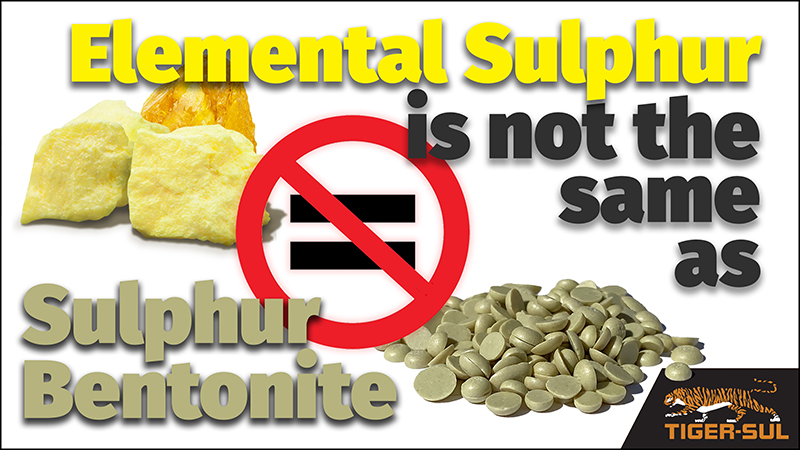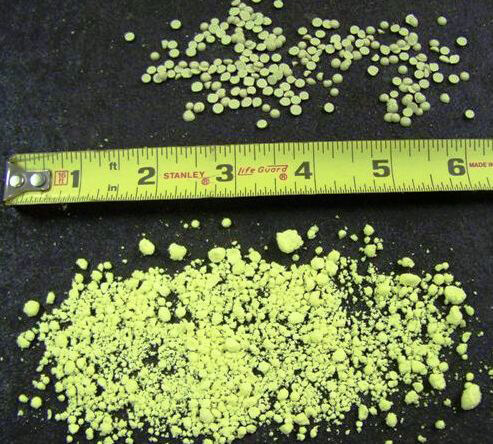Is There a Difference Between Elemental Sulphur and Sulphur Bentonite?
Wesley Haun, Senior Agronomist
David Annis, Jr., Technical Agronomist

Yes, there are significant differences, although very often the terms elemental sulphur (S) and sulphur bentonite (Tiger 90CR® Sulphur) are used interchangeably. While both products are valuable, they each have very specific uses. Elemental sulphur is utilized primarily in commercial industry and to lesser extent in production agriculture. Sulphur bentonite is a soil applied fertilizer as a plant nutrient source and as a soil amending product.
Elemental Sulphur
The characteristics of elemental sulphur are: non-metallic chemical element; a yellow crystalline solid; insoluble in water; odorless; and 99.5% pure. Elemental sulphur is utilized in several industries other than agriculture. These include those industries that are involved in non-ferrous metals, pigments, fibers, pharmaceuticals, personal care products, cosmetics, synthetic rubber vulcanization, and water treatment. Sulphuric acid is created by burning elemental sulphur. It is important to the fertilizer industry, which uses it to manufacture phosphates, and to lesser extent nitrogen, potassium, and sulphate fertilizers.
The “Bentonite” in Sulphur Bentonite
Generally, the term bentonite is used for any plastic, colloidal, swelling clay regardless of its geological origin. Bentonite clays are predominately composed of minerals from the montmorillonite group, which exhibit a significant amount of plasticity, cohesion, swelling, and shrinkage. These bentonite characteristics enhance the functionality of elemental sulphur by swelling and fracturing the sulphur particles into much smaller particle sizes.
Sulphur Particle Size
Importantly, sulphur particle size can be reduced through fracturing of the pastille with the addition of bentonite clay. Bentonite clay upon exposure to water has the capacity to swell up to 15 times its dry volume. Sulphur bentonite contains 10-15% clay. When field applied, the clay in the sulphur pastilles absorb soil moisture and swells resulting in the sulphur pastilles fracturing into very small particles. These particle sizes can range from 800 to 60 microns. Smaller sulphur particles provide greater surface area for Thiobacillus bacteria to feed on the sulphur and oxidize it to sulphate (SO4). There is an inverse relationship between particle size and surface area. As particle size decreases, there is a dramatic increase in surface area allowing more Thiobacillus bacteria to feed and convert the elemental S to plant available SO4. The oxidation rate increases exponentially as sulphur particle size decreases.
The Importance of Thiobacillus Bacteria

Figure 2: Thiobacillus is a rod-shaped bacterium that consumes sulphur.
If sulphur is so important for plant growth, how can it benefit plants when it is a solid and insoluble in water?
The answer is that sulphur must undergo microbial breakdown in soil prior to uptake by plants. This microbial process is sulphur oxidation, which converts elemental sulphur to plant available sulphate (SO4)-sulphur. Sulphur oxidation is a function of several factors including soil temperature, soil moisture, population of microorganisms (Thiobacillus), and sulphur particle size. Optimum conditions for greatest sulphur oxidation rates include soil temperatures between 65° to 95°F (18° to 35°C) and soil moisture slightly less than field capacity.
Sulphur oxidation also increases as the population of Thiobacillus bacteria increases. Thiobacillus bacteria population rises with repeated applications of sulphur. When sulphur is applied as part of a planned nutrient application program and applied annually or semi-annually, it provides ample food supply for the Thiobacillus bacteria. Therefore, the Thiobacillus bacteria become more active and reproduce as food supply supports the population. Greater bacteria population results in faster oxidation of S to SO4. Other aerobic and anaerobic bacteria including Beggiatoa, Thiothrix can convert S to SO4. Soils that may have lower populations of one bacterium, other types will become more active to facilitate the S oxidation process.
Sulphur: An Essential Plant Nutrient
Sulphur, along with NPK, is an essential plant nutrient. It contributes to crop yield increases via:
- direct plant nutrient value
- indirect plant value as a soil amendment, especially for calcareous/alkaline and/or sodic soil conditions
- the increased efficiency of other essential plant nutrients.
Pure Sulphur

Figure 2: Particle size variation with pure elemental sulphur (below ruler) compared to Tiger 90CR® Sulphur (above ruler).
Pure elemental sulphur (99.5%) is oftentimes referred to as “soil sulphur”. It has significantly larger particle sizes and a much slower oxidation rate as compared to sulphur pastilles containing bentonite clay. It is the larger particle sizes in elemental sulphur that require months to a year or longer for the oxidation process to occur (Fig. 2). Elemental sulphur is sometimes utilized as a nutrient source/soil amendment. Soil amendment is the addition of a product to soil to alter its physical, chemical, and/or biological characteristics to enhance plant growth. When soil pH is above the optimum range, elemental sulphur can be added in much higher quantities than needed for plant nutrients to create acidity in soil and lower the soil pH. When soil pH is reduced to within the optimum range there is greater availability of plant nutrients. Of course, Tiger 90CR sulphur can be applied as a soil amendment and providing faster reaction.
Production Process
There is an incorrect perception that Tiger-Sul® products are made by crushing dry elemental sulphur into very small particles and reforming to obtain a pastille (granule).
As referenced previously, elemental sulphur is a dry, yellow, crystalline solid that is not water soluble, but has a unique characteristic such that when heated to 240°F (116°C) it becomes a flowable product. When maintained in this flowable state it is referred as molten sulphur.
Tiger-Sul receives and processes elemental sulphur in the molten form. Therefore, the flowable sulphur can be pumped, and combined with additional ingredients to form a homogenized product. The mixed product flows through a metering devise employing “drop-form” technology that creates the droplets that fall onto a cooling belt. Once the droplets cool below 240°F they solidify as pastilles and can be handled as solid product.
It is the addition of bentonite clay to the sulphur matrix that enhances the functionality of the elemental sulphur. The bentonite clay is incorporated with molten sulphur to create Tiger 90CR. Tiger Micronutrients® are made by adding the bentonite clay into the sulphur matrix with desired micronutrients then agitated for a specific time to create a thoroughly mixed product. Since this is a homogenized product each pastille contains uniform amount of sulphur, clay, and/or micronutrients that can meet customers’ needs.
References